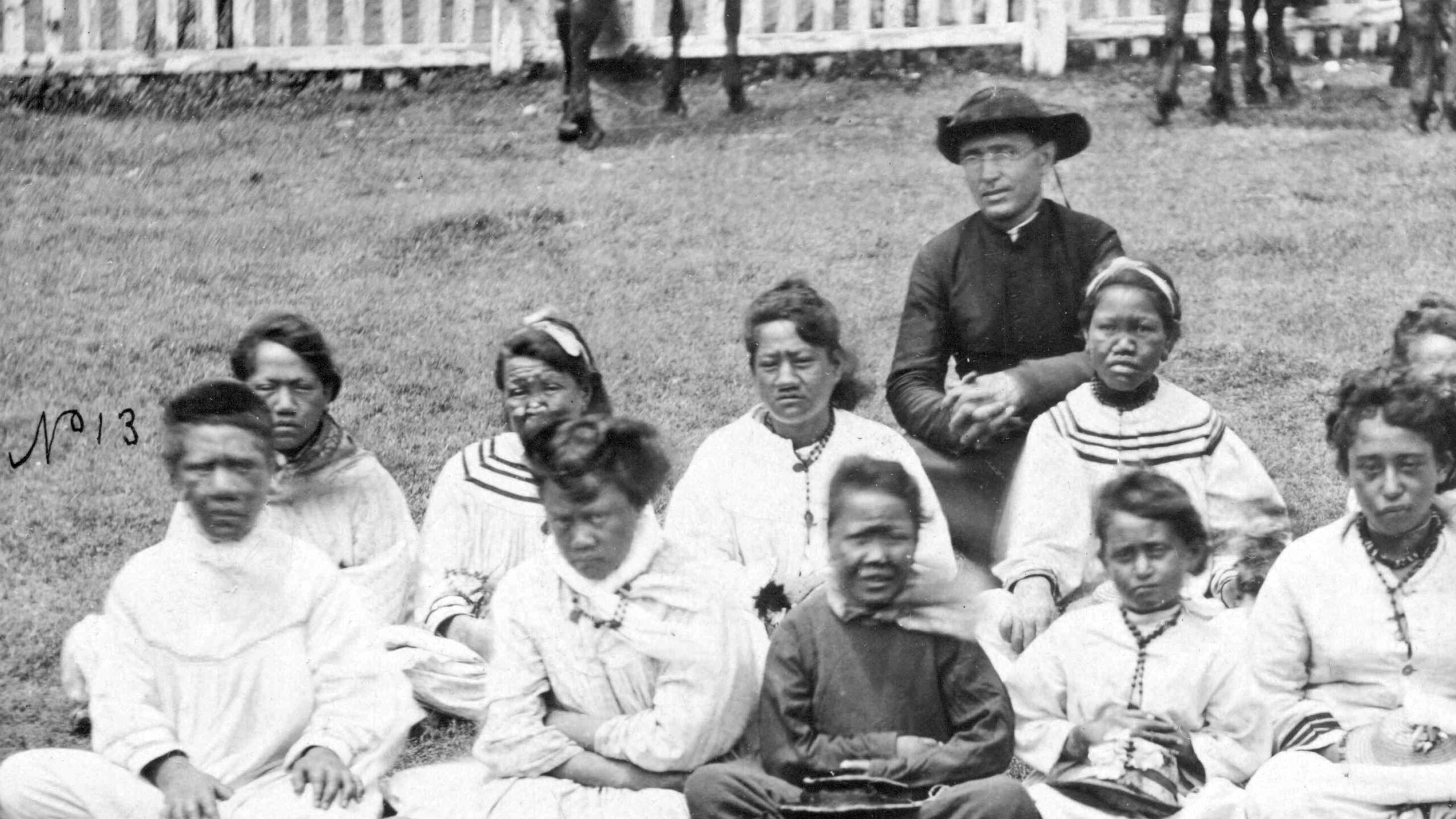Born on January 3, 1840, in Tremeloo near Louvain, Joseph De Veuster (Damien is his religious name) was the youngest surviving and seventh of the eight children of Frans and Anne-Catherine, Flemish-speaking farmers. Forty-nine years later, he died from leprosy, now known as Hansen’s disease, during Holy Week on Monday, April 15, 1889 in Kalawao of Molokai literally on the other side of the world, having ministered to those living and dying in exile in the settlement for sixteen years.
Pope Benedict XVI canonized St. Damien of Molokai on October 11, 2009 at St. Peter’s Basilica. It may seem odd that it should have taken over a century to canonize a man who devoted himself ardently to the care of the poorest of the poor, and literally spent his life in the imitation of Christ. A reading of Gavan Daws’ biography Holy Man: Father Damien of Molokai in light of the mimetic theory of René Girard—which argues that all human activity is rooted in imitation, the contagion of rivalry, and the sacrifice (and sacralization) of a scapegoat to create and maintain social order—can help to clarify this oddity.
In email exchanges with Daws—who is “not a Catholic, not a practicing Christian”—the author explained that an international competition to choose a sculptor for the statue of St. Damien of Molokai for Statuary Hall is what first caught his interest:
I did not know much about Damien, despite having written a general history of Hawaii, Shoal of Time. So I started to do some reading about him. There were plenty of accounts of his life, but to me they were all abstract: none of them really talked about him as a human being, living, working, and ultimately dying in particular circumstances in a particular place at a particular time. I thought a historical biography could be an interesting and useful project.
Holy Man appeared in 1973, a year after René Girard published Violence and the Sacred. The fact that the two works share many themes—such as mimetic desire, rivalry, contagion, scapegoating, sacrifice, prohibitions, etc.—is all the more interesting because Daws wrote his book entirely unaware of any of Girard’s texts. Daws told me that he was neither then, nor is he now, familiar with René Girard or mimetic theory. For this reason, a mimetic reading of Daws is all the more thrilling because it accords with Girard’s own claim that he did not invent mimetic theory but rather discovered it already at work.

Daws situates his biography of Father Damien within the context of the postmortem controversy—scandal, we could call it—about the moral worth of the “leper-priest,” and the possibility of coming to know Damien of Molokai as a human being. Father Damien’s global celebrity following his death had caused a good deal of discomfort to many inasmuch as his praiseworthy example of self-sacrificial love and Christian charity starkly contrasted with the government policy of exile and the conduct of the Protestants in Hawaii (who viewed the policy as legitimate as both an application of the ‘Mosaic’ instructions on ‘leprosy’ in Lev. 13-14 and of contemporary notions of public hygiene).
A stinging criticism of this celebrity came from the Reverend Doctor Charles McEwen Hyde, a prominent member of the American ascendancy in Honolulu, the capital of the then-still-independent Kingdom of Hawaii. In a letter to a fellow Protestant clergyman in California in 1889, Hyde writes:
We who know the man [Father Damien] are surprised by the extravagant newspaper laudation, as if he were a saintly philanthropist. The simple truth is, he was a course, dirty man, headstrong and bigoted. He did not stay in Molokai, but went there without orders; did not stay at the leper settlement (before he became one himself), but circulated freely over the whole island (less than half the island is devoted to the leper), and he came often to Honolulu. He had no hand in the reforms and improvements inaugurated, which were the work of the Board of Health, as occasion required and means provided. He was not a pure man in his relations with women, and the leprosy of which he died should be attributed to his vices and carelessness. Others have done much more for the lepers, our own ministers, the government physicians, and so forth, but never with the Catholic idea of meriting eternal life.
Daws succinctly sums up Hyde’s accusations: “Damien’s reputation was so much puffery: he was really nothing but a fraud and a lecher who brought his disease upon himself and deserved his death.”
Hyde’s letter to Gage and its accusations, which were widely disseminated in the popular press, did not go unanswered in its day, or in subsequent historical accounts. Having visited Kalawao shortly after Damien of Molokai’s death, Robert Louis Stevenson, who had sympathized with Damien’s story in part due to his own incurable tuberculosis, penned a six-thousand-word polemic in reply in early 1890. Daws observes that the affair fed on itself—an attack by one minister of God upon another, followed by a famous novelist’s defense of a dead man who could not defend himself: a man twice martyred, once by leprosy, once by slander, and now urgently in need of vindication in this world, if not the next.
The controversy, however, did open the way for something positive: an opportunity to deliver Father Damien from a certain kind of artificial sanctity that removes the humanity from the saint and in so doing renders the saint unattainable, and, consequently, virtually useless as a model to inspire and to imitate: “There is something hopeful in the thought, for all men as for the ‘leper-priest’; because as Stevenson said, if Damien was indeed a man, ‘with all the grime and paltriness of mankind,’ he was still ‘a saint and a hero all the more for that.’”
Daws entitles the second chapter “I am going in your place,” which were the words Damien of Molokai addressed to his brother, Auguste, upon receiving the news that he, Damien, was to be assigned to the Hawaiian missions in a letter from the Congregation’s Superior General in Paris. This moment succinctly captures the mimetic nature of their relationship, which upon Damien’s entrance into religious life changed from “brotherly emulation to a kind of holy competition.” His relationship with his brother Auguste influenced him throughout his lifetime, and he influenced his brother after his passing, bringing him eventually to Hawaii.
There is also an astounding collection of mimetic elements in his call to the religious life. Although Damien was initially inclined to the austerity and rigors of the Trappists, his brother persuaded him instead to join him and the Sacred Hearts Fathers. Joseph literally followed his brother to the novitiate in Louvain, where Auguste had become “Pamphile,” and where he was to become “Damien.” Feeling intensely drawn to become a missionary, Damien prayed before a picture of St. Francis Xavier daily during his studies, asking for this wish to be realized. Indeed, after having been assigned to the Hawaiian mission the same year as his brother’s ordination, Damien, twenty-three-years old and still not yet a priest himself, had himself photographed, showing “him standing, crucifix held to his heart, closely imitating the attitude of St. Francis Xavier in the picture before which he used to pray.” Indeed, Damien imitated Francis Xavier by eventually leaving Europe and serving in distant lands, unworried about the dangers and discomforts he had to face to spread the Gospel.

The fascinating mimetic associations in Father Damien’s journey continue with his rivalries with the Protestant missionaries and the Hawaiian kahuna by which he hoped to capture the hearts of the Hawaiian people for Jesus Christ. The fame that followed Damien’s work at Kalawao naturally exacerbated the rivalries between him and the Protestants: “They were embarrassed by it; and yet they could see no clear way to redeem their embarrassment.” In July 1873, the Hawaiian Evangelical Association resolved to preach vigorously for the segregation and exile of those suffering from leprosy; the thinly veiled implication of which was that those who resisted this path of action were going against God’s will and were therefore sinful. The juxtaposition between their approach, based on Leviticus, and Damien’s—which clearly imitated Jesus’ example in the Gospel—could not have been more striking.
In the fourth chapter, “A Peculiar Golgotha,” Daws further discusses the dominant theory of leprosy’s origin—namely, syphilis—to which both Damien of Molokai and his Protestant rivals subscribed. However, Damien nevertheless maintained his intimate contact with the Hawaiians of the settlement even as Protestants undertook an opposite movement of self-segregation from the general population (to avoid contagion). Since the latter judged Hawaiian culture as intrinsically corrupt and diseased, they hid from themselves the fact that it was the intrusion of Westerners that had brought leprosy in the first place. They blamed the victims for their own suffering, and only the expulsion to Kalawao might possibly save the Hawaiian Kingdom from self-destruction.
Eduard Christian Arning, a German bacteriologist, challenged the connection between syphilis and leprosy vigorously on numerous grounds. Father Damien, however, proved to be the most compelling refutation of this connection because, after a thorough physical examination, Arning and another doctor confirmed that while Damien had contracted leprosy, he never had syphilis. It must have been a humiliating experience, since the examination rather than his word was taken as proof of his innocence and his fidelity to his vow of chastity. It was not sexual promiscuity but rather his Christian charity that led to his infection. Following Christ, who ate with sinners and touched and was touched by the impure, Damien, in an analogous way, allowed himself to share the fate of those he served, so that they could place their trust in him, who had become like them.
Mimesis played a deep role in Father Damien’s life. And he imitated Christ—the ultimate Scapegoat who, as Girard saw, definitively reveals these anthropological realities—in freely laying that life down in death. By 1885, he began to speak to others about his condition. Writing to other members of his community, he explained that his leprosy was the fulfillment of his expectation that his acceptance of the work in the settlement 1873 would inevitably lead to infection, and he asked for their prayers to help obtain the grace to carry his cross behind Christ “on our peculiar Golgota of Kalawao”—a cross not carried alone, but with other fellow sufferers of leprosy, carrying the same cross, leading to the same salvation.
This piece was originally published on October 9, 2020 on WordonFire.org.
